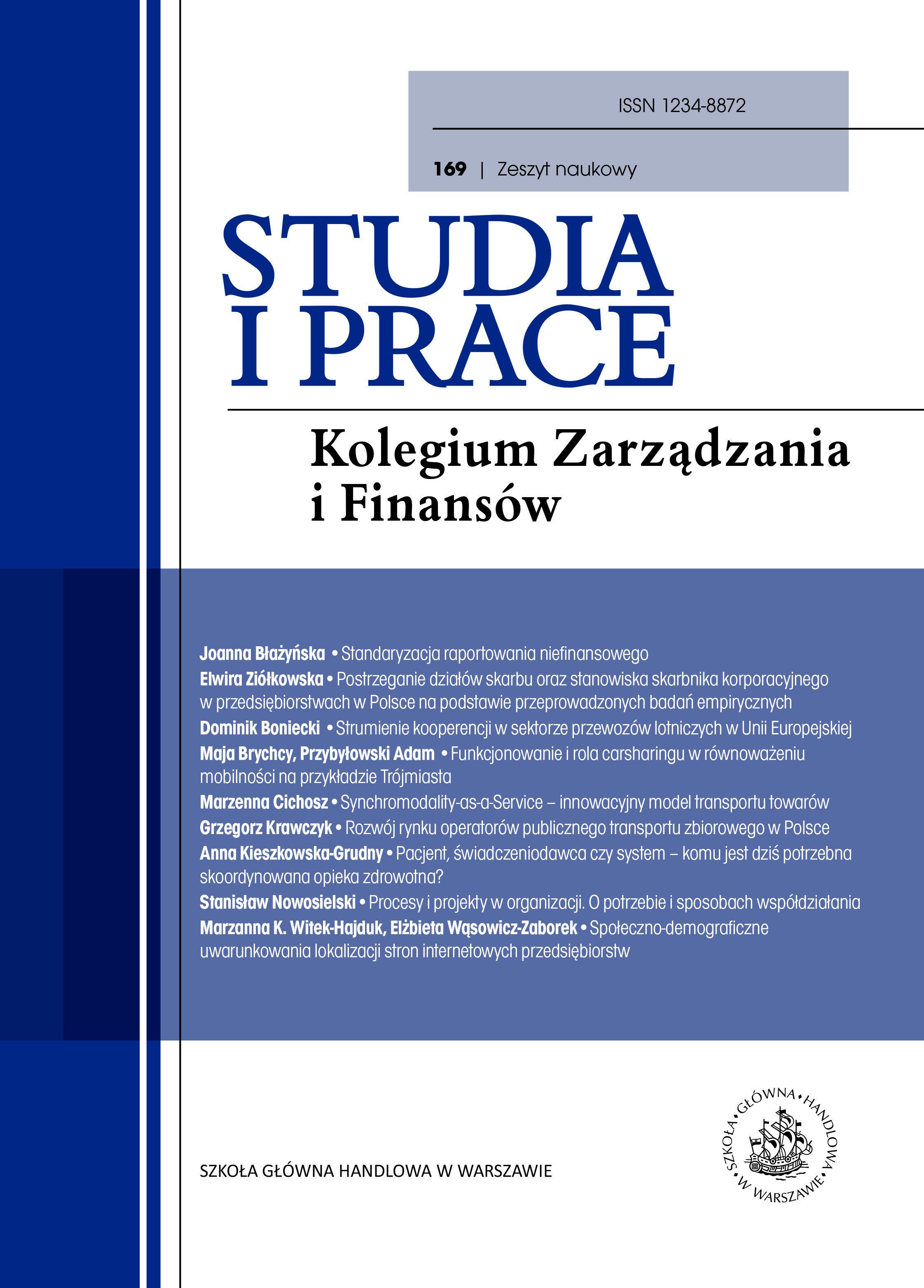Patient, provider or the system: who needs coordinated healthcare?
DOI:
https://doi.org/10.33119/SIP.2018.169.7Keywords:
aging society, health, healthcare, coordinated healthcare, integrated healthcareAbstract
Aging society, growing medical needs and limited resources, as well as rapidly progressing development of medical technologies are challenges faced by healthcare systems across the world. Coordinated healthcare that is being delivered in more than 100 formats globally, is a management approach to the delivery of medical services that ensures continuity and comprehensiveness in diagnostics and treatment at improved efficiency and reduced costs. In Poland, coordination of medical services is only just gaining ground and limited resources available in the healthcare system make it a viable option that offers improved access to modern healthcare services with better surveillance and cost management as well as optimisation of outlays.
Downloads
References
2. van den Berg M. J., Loenen van T., Wester G. P., Accessible and continuous primary care may help reduce rates of emergency department use. An international survey in 34 countries, „Family Practice” 2016; 33 (1): 42–50.
3. von Bertalanffy L., General System theory: foundations, development, applications. Revised edition, Penguin University Books, London 1969.
4. Coleman K. et al., Evidence on the Chronic Care Model in the new millennium, „Health Affairs” 2009; 28 (1): 75–85.
5. D’Amour D. et al., The conceptual basis for interprofessional collaboration: core concepts and theoretical frameworks, „Journal of Interprofessional Care” 2005; 19 (Suppl 1): 116–131.
6. Goodwin N., Alonso A., Understanding integrated care: the role of information and communication technology [w:] Achieving Effective Integrated E-Care Beyond the Silos, I. Meyer (ed.), Medical Information Science Reference, Hershey 2014: 63–82.
7. Haggerty J. L. et al., Management Continuity from the Patient Perspective: Comparison of Primary Healthcare Evaluation Instruments, „British Medical Journal” 2003; 327 (7425): 1219– 1221.
8. Ham C. et al., Hospital bed utilisation in the NHS, Kaiser Permanente, and the US Medicare programme: analysis of routine data, „BMJ” 2003; 327 (7426): 1257.
9. Hansen J., Living in a country with a strong primary care system is beneficial to people with chronic conditions, „Health Affairs” 2015; 34 (9): 1531–1537.
10. Lemmens K. M., Nieboer A. P., Huijsman R., A systematic review of integrated use of disease-management interventions in asthma and COPD, „Respiratory Medicine” 2009; 103 (5): 670–691.
11. Leutz W. N., Five laws for integrating medical and social services: lessons from the United States and the United Kingdom, „Milbank Quarterly” 1999; 77 (1): 77–110.
12. van der Linden B., The birth of integration, explorative studies on the development and implementation of transmural care in the Netherlands, 1994–2000, Utrecht University, Utrecht 2001.
13. van Loenen T. et al., Organizational aspects of primary care related to avoidable hospitalization: a systematic review, „Family Practice” 2014; 31 (5): 502–516.
14. Mercier G. et al., Geographic variation in potentially avoidable hospitalizations in France, „Health Affairs” 2015; 34 (5): 836–843.
15. Ouwens M., Wollersheim H., Hermens R., Hulscher M., Grol R., Integrated care programmes for chronically ill patients: a review of systematic reviews, „International Journal for Quality in Health Care” 2005; 17 (2): 141–146.
16. Primary care and public health: exploring integration to improve population health, The National Academies Press, Washington 2012.
17. Valentijn P. et al., Understanding integrated care: a comprehensive conceptual framework based on the integrative functions of primary care, „International Journal of Integrated Care” 2013; 13: e010.
18. Vos T. et al., Global, regional, and national incidence, prevalence, and years lived with disability for 301 acute and chronic diseases and injuries in 188 countries, 1990–2013: a systematic analysis for the Global Burden of Disease Study 2013, „Lancet” 2015; 386 (9995): 743–800.
Materiały internetowe
1. GUS, Ludność w wieku 60+. Struktura demograficzna i zdrowie. Zdrowie osób starszych w Polsce w świetle badań statystyki publicznej, 2016, http://stat.gov.pl/obszary-tematyczne/ludnosc/ludnosc/ludnosc-w-wieku-60‑struktura-demograficzna-i-zdrowie,24,1.html [dostęp: 11.2017].
2. GUS, Rocznik Demograficzny 2017, http://stat.gov.pl/obszary-tematyczne/roczniki-statystyczne/roczniki-statystyczne/rocznik-demograficzny-2017,3,11.html [dostęp: 12.2017].
3. GUS, Zdrowie i zachowania zdrowotne mieszkańców Polski w świetle badania EHIS 2014, 2015, http://stat.gov.pl/obszary-tematyczne/zdrowie/zdrowie/zdrowie-i-zachowania-zdrowotne-mieszkancow-polski-w-swietle-badania-ehis-2014,10,1.html [dostęp: 11.2017].
4. Komenda Główna Policji, Wybrane statystki, zamachy samobójcze, 2013–2016, http://statystyka.policja.pl/st/wybrane-statystyki/zamachy-samobojcze/122324, Zamachy-samobojcze-od-2013‑roku.html [dostęp: 11.2017].
5. Ministerstwo Zdrowia, Narodowy Fundusz Zdrowia, Projekt pozakonkursowy pt. „Przygotowanie, przetestowanie i wdrożenie do systemu opieki zdrowotnej organizacji opieki koordynowanej (OOK) – Etap I Opracowanie modeli zintegrowanej/koordynowanej opieki zdrowotnej dla Polski”, Warszawa 2015, https://akademia.nfz.gov.pl/ook/ [dostęp: 11.2017].
6. Montefiore Medical Center, About us, 2018, http://www.montefiore.org/about [dostęp: 07.2018].
7. NFZ, Podstawowa opieka zdrowotna i profilaktyka w podstawowej opiece zdrowotnej w Europie, 2016, www.nfz.pl [dostęp: 11.2017].
8. NFZ, Spotkanie otwierające w ramach projektu „Przygotowanie, przetestowanie i wdrożenie do systemu opieki zdrowotnej organizacji opieki koordynowanej (OOK) – Etap I Opracowanie modeli zintegrowanej/koordynowanej opieki zdrowotnej dla Polski”, współfinansowanego przez UE w ramach Programu Operacyjnego Wiedza Edukacja Rozwój, Warszawa 2016, http://www.nfz.gov.pl/aktualnosci/aktualnosci-centrali/spotkanie-i-warsztaty-dotyczace-organizacji-opieki-koordynowanej-ook,6838.html [dostęp: 11.2017].
9. Naczelna Izba Lekarska w Warszawie, Zestawienie liczbowe lekarzy i lekarzy dentystów,
10.10.2017, http://www.nil.org.pl/__data/assets/pdf_file/0008/114488/Zestawienie-nr-02.pdf [dostęp: 11.2017].
10. Naczelna Izba Pielęgniarek i Położnych, Raport Naczelnej Rady Pielęgniarek i Położnych Zabezpieczenie Społeczeństwa Polskiego w Świadczenia Pielęgniarek I Położnych, 2017, http://nipip.pl/wp-content/uploads/2017/03/Raport_druk_2017.pdf [dostęp: 11.2017].
11. Najwyższa Izba Kontroli, Realizacja Zadań Narodowego Funduszu Zdrowia w 2016 Roku. KZD.430.005.2017; Nr ewid. 157/2017/P/17/056/KZD, 2017, https://www.nik.gov.pl/plik/id,15437, vp,17919.pdf [dostęp: 11.2017].
12. OECD, Health at a Glance 2017: OECD Indicators, OECD Publishing, Paris 2017, http://dx.doi.org/10.1787/health_glance-2017‑en [dostęp: 11.2017].
13. Shaw S., Rosen R., Rumbold B., What is integrated care? Research report, „Nuffield Trust” 2011, s. 13, https://www.nuffieldtrust.org.uk/files/2017–01/what-is-integrated-care-report-web-final.pdf [dostęp: 11.2017].
14. United Nations, Department of Economic and Social Affairs, Population Division, World Population Prospects: The 2017 Revision, 2017, (https://esa.un.org/unpd/wpp/DataQuery/[dostęp: 11.2017].
15. World Health Organisation, WHO global strategy on integrated people-centred health services 2016–2026, 2015, http://apps.who.int/iris/bitstream/10665/180984/1/WHO_HIS_SDS_2015.20_eng.pdf?ua=1 [dostęp: 11.2017].









